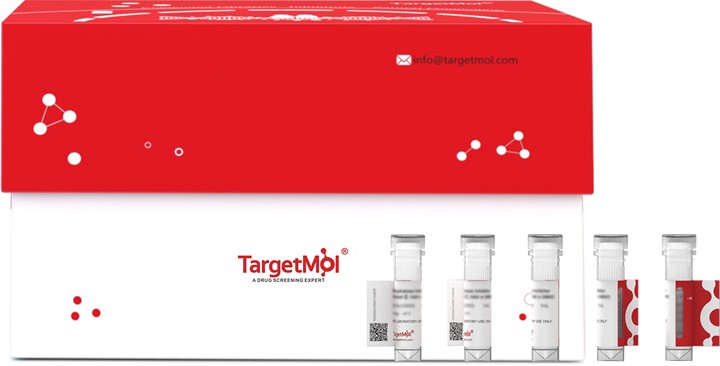 Your shopping cart is currently empty
Your shopping cart is currently empty
SLP-76 Protein, Human, Recombinant (His)
Lymphocyte cytosolic protein 2(LCP2)contains a SAM domain and a SH2 domain. It is highly expressed in spleen, thymus and peripheral blood leukocytes, T-cell and monocytic cell lines, but expressed at lower level in B-cell lines. LCP2 was originally identified as a substrate of the ZAP-70 protein tyrosine kinase following T cell receptor (TCR) ligation in the leukemic T cell line Jurkat. It is phosphorylated after T-cell receptor activation by ZAP70, ITK and TXK, which leads to the up-regulation of Th1 preferred cytokine IL-2 during post-translational modification. Studies using LCP2-deficient T cell lines or mice have provided strong evidence that SLP-76 plays a positive role in promoting T cell development and activation as well as mast cell and platelet function.

SLP-76 Protein, Human, Recombinant (His)
| Pack Size | Price | USA Warehouse | Global Warehouse | Quantity |
|---|---|---|---|---|
| 5 μg | $112 | 7-10 days | 7-10 days | |
| 10 μg | $183 | 7-10 days | 7-10 days | |
| 20 μg | $292 | 7-10 days | 7-10 days | |
| 50 μg | $545 | 7-10 days | 7-10 days | |
| 100 μg | $792 | 7-10 days | 7-10 days | |
| 200 μg | $1,150 | 7-10 days | 7-10 days | |
| 500 μg | $1,900 | 7-10 days | 7-10 days | |
| 1 mg | $2,970 | 7-10 days | 7-10 days |
Product Information
| Biological Activity | Activity has not been tested. It is theoretically active, but we cannot guarantee it. If you require protein activity, we recommend choosing the eukaryotic expression version first. |
| Description | Lymphocyte cytosolic protein 2(LCP2)contains a SAM domain and a SH2 domain. It is highly expressed in spleen, thymus and peripheral blood leukocytes, T-cell and monocytic cell lines, but expressed at lower level in B-cell lines. LCP2 was originally identified as a substrate of the ZAP-70 protein tyrosine kinase following T cell receptor (TCR) ligation in the leukemic T cell line Jurkat. It is phosphorylated after T-cell receptor activation by ZAP70, ITK and TXK, which leads to the up-regulation of Th1 preferred cytokine IL-2 during post-translational modification. Studies using LCP2-deficient T cell lines or mice have provided strong evidence that SLP-76 plays a positive role in promoting T cell development and activation as well as mast cell and platelet function. |
| Species | Human |
| Expression System | E. coli |
| Tag | N-T7, C-6xHis |
| Accession Number | Q13094 |
| Synonyms | SLP-76 tyrosine phosphoprotein,SLP76,SH2 domain-containing leukocyte protein of 76 kDa,Lymphocyte cytosolic protein 2,LCP2 |
| Amino Acid | Met1-Pro533 |
| Construction | Met1-Pro533 |
| Protein Purity | Greater than 95% as determined by reducing SDS-PAGE. (QC verified) |
| Molecular Weight | 70 KDa (reducing condition) |
| Endotoxin | < 0.1 ng/µg (1 EU/µg) as determined by LAL test. |
| Formulation | Supplied as a 0.2 μm filtered solution of 20 mM Tris-HCl, 200 mM NaCl, 20% Glycerol, pH 8.5. |
| Stability & Storage | Lyophilized powders can be stably stored for over 12 months, while liquid products can be stored for 6-12 months at -80°C. For reconstituted protein solutions, the solution can be stored at -20°C to -80°C for at least 3 months. Please avoid multiple freeze-thaw cycles and store products in aliquots. |
| Shipping | Shipping with blue ice. |
| Research Background | Lymphocyte cytosolic protein 2(LCP2)contains a SAM domain and a SH2 domain. It is highly expressed in spleen, thymus and peripheral blood leukocytes, T-cell and monocytic cell lines, but expressed at lower level in B-cell lines. LCP2 was originally identified as a substrate of the ZAP-70 protein tyrosine kinase following T cell receptor (TCR) ligation in the leukemic T cell line Jurkat. It is phosphorylated after T-cell receptor activation by ZAP70, ITK and TXK, which leads to the up-regulation of Th1 preferred cytokine IL-2 during post-translational modification. Studies using LCP2-deficient T cell lines or mice have provided strong evidence that SLP-76 plays a positive role in promoting T cell development and activation as well as mast cell and platelet function. |
Dose Conversion
Calculator
Tech Support
| Size | Quantity | Unit Price | Amount | Operation |
|---|

Copyright © 2015-2025 TargetMol Chemicals Inc. All Rights Reserved.



